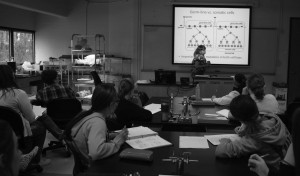The near-steady percentage of women studying natural sciences at IU Southeast indicates that science-based fields are no longer considered a man’s turf.
Science, technology, engineering and mathematics (STEM) programs have seen a steep increase in employment of women during the past 40 years, reshaping ideas of a woman’s position in society and capabilities.
Since 2004, women have made up at least 44.9 percent of natural science students at IU Southeast. In 2008, they surpassed men, making up 50.5 percent of the natural science body.
Last school year, 46.2 percent of natural science students at IU Southeast were female.
“Twenty years ago, I was the first woman to teach the introductory chemistry course for chemistry majors,” Elaine Haub, dean of the school of natural sciences, said.
“Within the first couple of years of teaching this course, there was a 50 percent increase in the number of female chemistry majors. Currently, the majority of undergraduate students on our campus are female, and it is not unusual for the majority of students in many of the science courses to be female.”
Women made up 57.9 percent of IUS undergraduates for the fall 2012-2013 school year and 63.3 percent of graduate students.
Haub received her bachelor of science in chemistry from IU Southeast in 1987 and her Ph. D. in chemistry from UofL in 1993.
Although fewer women were studying sciences while she was a student at IU Southeast, she said that she didn’t experience gender bias.
“As an IUS student, I was very lucky to have chemistry mentors that judged me on my science skills and not my gender,” Haub said.
“I was also fortunate to have a woman chemist, Professor JoAnn Jansing, as a mentor. She was the first woman scientist at IUS to earn promotion to full professor. I am only the third.”
Female Bias in STEM Jobs
U.S. Census Bureau data from 2011 documents women’s employment in STEM occupations from 1970 and later shows a steep increase of women in the sciences.
As of 2011, women made up 61 percent of the social sciences work force, compared to 17 percent in 1970.
Women hold 47 percent of mathematical jobs in the U.S., compared to just 15 percent in 1970.
While this data sample illustrates the increase of women employment in STEM occupations, other areas still fail to employ as many women.
Few women hold engineering jobs, making up only 13 percent of the workforce. Only 27 percent of computer professionals, a field providing nearly half of all STEM occupations, are women.
“Women have made progress in the last 20 years of narrowing the gender gap in science but there is still a long way to go,” Haub said.
“National data show that women in science are paid less and promoted less than their male counterparts, whether working in academia or industry.”
A study conducted by researchers at Yale University last summer revealed “a continuing bias against women in the sciences” from wage gaps to obtaining a job.
Professors from six major research institutions were given two identical imaginary applications and majorly chose to hire the male applicant. Women who were chosen for the proposed position were, on average, offered a salary that was nearly $4,000 less than the man’s.
The same study proved that young males with the same qualifications as a female are viewed as more favorable candidates among biologists, chemists and physicists.
Today, women hold only one-fifth of the physics PhDs awarded in the United States, and a slim 14 percent of physics professors are females.
Evengiya Moiseeva, physics PhD graduate from University of Louisville, said she believes there are some more personal factors that play a role in the statistics about women obtaining PhDs in a science field.
“I think it’s [the reason for women not entering STEM fields] different for different people,” Moiseeva said.
“A PhD takes an average of five to six years, and for  some women, they think that they are spending all their youth. If you’re family oriented, you’ll focus on family and save education for later.”
some women, they think that they are spending all their youth. If you’re family oriented, you’ll focus on family and save education for later.”
Moiseeva received both her masters and bachelor’s degree in Russia and moved to Louisville to pursue a PhD in physics.
“I was inspired [to study a science] by my high school chemistry teacher and physics teacher, who were both women,” Moiseeva said. “I spoke with them about university plans and they liked the idea of it, and both encouraged me to enter one of the sciences.”
Targeting primary
and secondary students
Some companies and organizations are making initiatives to promote STEM education among girls.
GoldieBlox, a company whose toys are designed to “inspire future engineers,” has completely dismantled the concept of “female toys” and literally constructed an alternative.
Their initiative aims to steer young girls away from Barbie by providing them with construction toys that stimulate interest in STEM subjects, which some girls are losing interest in as early as age eight.
Haub also stressed the influence female teachers can have on women interested in pursuing an education or career in the sciences.
“We can tell women that they can be scientists, but it is a more powerful message when a woman scientist can say, ‘I did it, you can do it too!’” Haub said.
Marvel comic book creators are also involved in promoting STEM studies to younger girls, launching the Marvel Ultimate Mentor Adventure competition this fall with a chance to be flown to “The Dark World” premiere in Hollywood.
High school girls interested in studying a STEM subject were asked to interview a woman working in STEM and follow up with a short video about the interview and why they want to pursue a STEM career.
Despite the initiatives to promote females in the sciences, Haub said she believes it will still take more time before some college careers are completely focused on skill rather than gender.
“Education is the key to the upward mobility and autonomy of all, not just women,” Haub said. “Perhaps one day a person’s choice of college major and career will be based solely upon the person’s interests and natural skills with no gender bias. We have made strides in the right direction, but we’re not there yet.”






